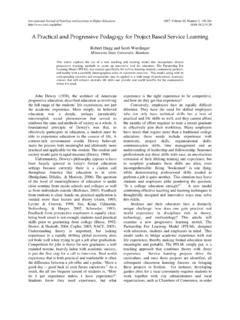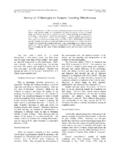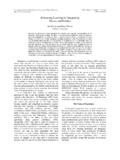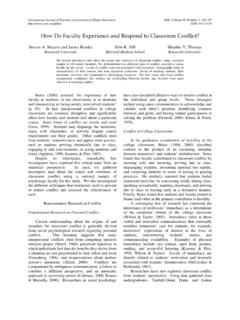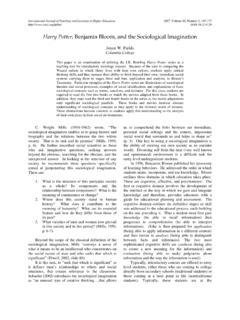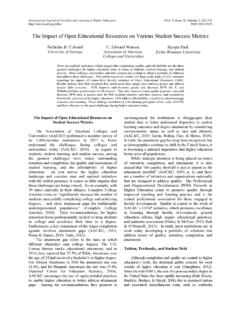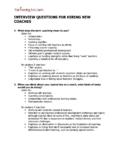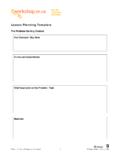Transcription of Lesson Study as a Model for Building Pedagogical …
1 International Journal of Teaching and Learning in Higher Education 2006, Volume 18, Number 3, 250-257 ISSN 1812-9129 Lesson Study as a Model for Building Pedagogical Knowledge and Improving Teaching William Cerbin and Bryan Kopp University of Wisconsin La Crosse This paper proposes a Model for Building Pedagogical knowledge and improving teaching based on the practice of Lesson Study . In Lesson Study a small group of instructors jointly designs, teaches, studies and refines a single class Lesson called a research Lesson . We describe how college teachers can do Lesson Study in their classrooms.
2 We explore how the practice of Lesson Study creates multiple pathways for improving teaching and how the knowledge teachers create can help to advance the practice of teaching in their fields. On any given day thousands of college instructors enter similar classrooms to teach similar, if not identical, subjects. Despite similar Pedagogical goals, approaches and experiences, teachers typically work alone when planning instructional activities and assignments. Such isolation limits efforts to improve college teaching on a broader scale, both within and across disciplines.
3 Although individual teachers may reflect on and improve their practice, there are few occasions to converse with colleagues about what they discover about teaching and learning. When they do share their ideas about teaching, it likely takes the form of knowledge they develop from their experiences in the classroom. Although practitioner knowledge is immediately useful for the teacher, it tends to be tied to concrete and specific contexts (Hiebert, Gallimore, & Stigler, 2002). It is not always in a form that can be accessed and used by others.
4 In order to become professional knowledge, practitioner knowledge must also be made public, shareable, and verifiable (Hiebert et al., 2002). How can college teachers improve teaching practice in their fields and, in the process, contribute to the formation of a professional knowledge base? One answer is Lesson Study , as Hiebert et al. (2002) suggest. Lesson Study is a teaching improvement and knowledge Building process that has origins in Japanese elementary education. In Japanese Lesson Study teachers work in small teams to plan, teach, observe, analyze, and refine individual class lessons, called research lessons.
5 Nearly all Japanese teachers participate in a Lesson Study team during a school year. In addition, they observe research lessons regularly in their own schools and at schools that host Lesson Study open houses. Research lessons are published and widely disseminated throughout the country. In essence Japanese Lesson Study is a broad-based, teacher-led system for improvement of teaching and learning. In this article we propose a Model of Lesson Study for the college classroom, and explore how college teachers can improve their practice and the practice of teaching in their fields through Lesson Study .
6 We draw from our experience with the College Lesson Study Project (CLSP), which began in fall 2003 with four Lesson Study teams in Biology, Economics, English, and Psychology. By spring 2006, participation increased to 40 teams involving more than 150 instructors in approximately 25 disciplines on 10 campuses in the University of Wisconsin System. At the University of Wisconsin-La Crosse nearly 24% of fulltime instructors have participated in Lesson Study since fall 2003. As practitioners of Lesson Study and coordinators of the College Lesson Study Project, we are in a unique position to discuss the opportunities as well as the challenges of doing Lesson Study at the college level and to comment on how Lesson Study makes possible the creation, exchange, and use of professional knowledge in teaching.
7 A Model of Lesson Study for the College Classroom In developing a Model of Lesson Study for college teachers, we have attempted to retain essential features of the Japanese Model , making necessary changes to adapt to the contexts and purposes of American higher education, which are in no way uniform across institutions or disciplines. We acknowledge the Japanese Model as the intellectual inspiration for our work and recommend the work of scholars who have brought Lesson Study to the attention of Western educators and researchers (Chokshi & Fernandez, 2004; Fernandez & Chokshi, 2002; Fernandez & Yoshida, 2004; Lewis, 1998a, 1998b, 2002; Lewis & Tsuchida, 1997, 1998; Stigler & Hiebert, 1999; Yoshida, 1999).
8 Whether in Japan or the United States, Lesson Study involves a small team of instructors working together to design, teach, Study , and refine a single class Lesson . This work culminates in at least two tangible products: (a) a detailed, usable Lesson plan, and (b) an in-depth Study of the Lesson that investigates teaching and learning interactions, explaining how students responded to instruction, and how instruction might be further modified based on the evidence collected. Aspects of Lesson Study resemble other teaching Cerbin and Kopp Lesson Study 251 improvement strategies such as backward design (Wiggins & McTighe, 1998) and classroom assessment (Angelo & Cross, 1993).
9 A closer look at how the Lesson Study process plays out in higher education, however, reveals important differences with other teaching improvement activities in the United States as well as differences with the Japanese Model . Below we briefly discuss key steps in the process. Formulating Learning Goals Lesson Study teams usually consist of 3-6 instructors from the same discipline although there could be interdisciplinary teams. They begin by selecting a course, topic and goals for student learning. Instructors select a topic of interest to them, usually one that is important in the discipline or course, one that poses problems for students, or one that is new to the curriculum.
10 Ideally, a research Lesson addresses immediate academic learning goals ( , understanding specific concepts and subject matter) and broad goals for development of intellectual abilities, habits of mind and personal qualities. In Japan, schools often have a research focus that specifies important school-wide goals that include qualities of character, dispositions and sensibilities such as curiosity, independent thinking, tolerance of individual differences and so forth. In lieu of an institutional research focus, college teachers can link their research lessons to institution-wide aims for student learning ( , critical thinking) or learning goals specific to an academic program or discipline.
